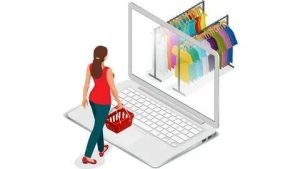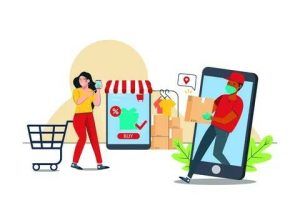Online shopping in 2023 continues to be a popular and convenient way to purchase a wide range of products and services. Here are some key trends and aspects to consider:
- Increased mobile shopping: The use of smartphones and mobile devices for online shopping continues to rise. Mobile apps and optimized mobile websites provide seamless shopping experiences, allowing customers to browse and purchase products on the go.
- Personalization and recommendation engines: E-commerce platforms leverage artificial intelligence and machine learning algorithms to personalize the shopping experience. They analyze customer data, purchase history, and browsing behavior to provide tailored product recommendations, personalized offers, and targeted advertisements.
- Voice-activated shopping: Voice assistants like Amazon’s Alexa, Apple’s Siri, and Google Assistant have gained prominence in online shopping. Consumers can use voice commands to search for products, add items to their carts, and complete purchases. Voice-activated shopping is expected to become more widespread in 2023.
- Augmented Reality (AR) and Virtual Reality (VR): AR and VR technologies are being integrated into online shopping experiences. They enable customers to virtually try on clothing and accessories, visualize furniture in their homes, or explore products in a more interactive and immersive way, enhancing the online shopping experience.
- Same-day and one-hour delivery: Expedited delivery options are becoming more common, with retailers offering same-day or one-hour delivery services in certain regions. This allows customers to receive their orders quickly, catering to their need for instant gratification and convenience.
It’s important to note that online shopping experiences can vary across different regions, platforms, and retailers. Factors like shipping costs, return policies, and customer support should be considered when choosing online retailers. Additionally, staying vigilant about online security, comparing prices, and reading product descriptions and reviews can help make informed purchasing decisions in the online shopping landscape of 2023.
Increased mobile shopping
Increased mobile shopping is a significant trend in the world of online shopping. Here are some key aspects to consider when it comes to mobile shopping:
- Mobile-friendly websites and apps: Retailers are optimizing their websites and developing dedicated mobile apps to provide a seamless shopping experience on smartphones and tablets. Look for retailers with user-friendly mobile interfaces that make browsing, searching, and purchasing products easy and intuitive.
- Mobile payment options: Mobile shopping is made more convenient with various mobile payment options. Digital wallets like Apple Pay, Google Pay, and Samsung Pay allow users to make secure and quick payments with their smartphones. Look for retailers that support these mobile payment methods to streamline the checkout process.
- Responsive design: A responsive website design ensures that the retailer’s website adapts to different screen sizes and resolutions. This allows for a consistent and optimized shopping experience across various mobile devices, ensuring that product images, descriptions, and navigation remain clear and accessible.
- Push notifications and alerts: Retailers often utilize push notifications and alerts on their mobile apps to notify users of exclusive deals, discounts, or limited-time offers. Opting in to receive these notifications can help you stay informed about the latest promotions and sales.
- Mobile-exclusive promotions: Some retailers offer exclusive promotions and discounts specifically for mobile app users. These promotions can include app-only coupon codes, flash sales, or personalized offers. Taking advantage of these mobile-exclusive deals can lead to additional savings.
Personalization and recommendation engines
Personalization and recommendation engines have become prominent trends in online shopping. Here’s what you should consider when it comes to these aspects:
- Tailored product recommendations: Many online retailers use recommendation engines to analyze your browsing history, purchase behavior, and demographic information to provide personalized product recommendations. Consider shopping with retailers that offer tailored suggestions based on your preferences, as this can help you discover new products or find items that align with your interests.
- Customized shopping experiences: Online retailers strive to offer personalized shopping experiences. This includes displaying relevant product categories, personalized landing pages, and targeted promotions based on your previous interactions with the website or app. Look for retailers that take a personalized approach to enhance your shopping journey.
- Account personalization: Creating an account with an online retailer allows you to personalize your shopping experience further. This includes saving your preferences, payment details, and shipping addresses, making future purchases more convenient. Take advantage of account personalization features to streamline your online shopping process.
- Wishlists and saved items: Recommendation engines often work in tandem with wishlist and saved item functionalities. By saving items you’re interested in, you enable the retailer to provide more accurate recommendations and alerts when those items go on sale. Utilize wishlist features to keep track of items you want to purchase in the future.
- Customer segmentation: Online retailers segment their customer base into different groups based on various criteria like demographics, behavior, or purchase history. This segmentation helps retailers provide targeted offers and personalized communication. Consider how the retailer you’re shopping with segments its customers and if it aligns with your preferences and needs.

Voice-activated shopping
Voice-activated shopping has become increasingly popular and convenient for online shoppers. Here are some trends and aspects to consider when engaging in voice-activated shopping:
- Compatibility with voice assistants: Voice-activated shopping https://www.buydo.eu relies on voice assistant technologies like Amazon’s Alexa, Apple’s Siri, Google Assistant, or Microsoft’s Cortana. Ensure that the online retailer you wish to shop from supports the voice assistant you have available on your device.
- Voice-enabled devices: Voice-activated shopping can be done through various devices, including smart speakers, smartphones, tablets, and even smart TVs. Verify that your device is equipped with voice activation capabilities and that it is compatible with the retailer’s voice shopping platform.
- Seamless voice commands: When shopping through voice commands, it’s crucial to use clear and concise language to convey your shopping requests accurately. Familiarize yourself with the voice commands supported by the voice assistant and the retailer’s specific voice shopping features.
- Product availability and selection: While voice-activated shopping offers convenience, it’s essential to consider that not all products may be available or easily searchable through voice commands. Some retailers may have limitations on the types of products or specific brands that can be purchased using voice shopping.
- Security and authentication: Voice-activated shopping requires a level of trust and security, particularly when it comes to making purchases. Ensure that the retailer and the voice assistant platform have robust security measures in place, such as voice recognition or multi-factor authentication, to protect your personal and financial information.
Augmented Reality (AR) and Virtual Reality (VR)
Augmented Reality (AR) and Virtual Reality (VR) are emerging trends in online shopping that offer immersive and interactive experiences. Here are some aspects and considerations when it comes to using AR and VR in your online shopping journey:
- Virtual product visualization: AR and VR technologies allow you to visualize products in a more interactive and realistic way. With AR, you can superimpose virtual objects onto the real world using your smartphone or tablet camera. VR, on the other hand, creates a fully immersive virtual environment using a headset. Consider retailers that offer AR or VR experiences to better visualize products before making a purchase.
- Try-before-you-buy experiences: AR and VR can enable “try-before-you-buy” experiences, particularly in industries like fashion and home decor. Virtual try-on features allow you to see how clothing items or accessories would look on you, while virtual home design tools help you visualize furniture and decor in your space. Look for retailers that offer these interactive experiences to make more informed purchasing decisions.
- Enhanced product details: AR and VR can provide additional product information and details. For example, you can explore the features and functionality of a complex electronic gadget in a virtual environment or view 3D models of products from different angles. Consider retailers that utilize AR or VR to provide a more comprehensive understanding of their products.
- Store exploration in virtual environments: VR can offer virtual store environments where you can explore and browse products as if you were physically present in a store. This can be particularly useful for large retailers or when shopping for items in physical stores that are geographically distant. Look for retailers that provide VR store experiences for a unique and immersive shopping experience.
- Size and fit accuracy: AR and VR technologies can help address sizing and fit concerns. Virtual fitting rooms, for example, allow you to virtually try on clothing and assess how well they fit before making a purchase. Check if retailers offer these features to minimize size-related uncertainties when shopping online.
Same-day and one-hour delivery
Same-day and one-hour delivery have become increasingly popular trends in online shopping. Here are some aspects and considerations to keep in mind when opting for these delivery options:
- Retailer availability: Not all retailers offer same-day or one-hour delivery. Check if the retailer you want to shop from provides these expedited delivery options. Some larger retailers or online marketplaces may have their own fulfillment networks or partnerships with local delivery services to offer faster delivery.
- Geographic coverage: Same-day and one-hour delivery services are typically available in select areas or cities. Ensure that your location is within the serviceable area before choosing these delivery options. Some retailers may have a dedicated webpage or feature that allows you to check the availability of fast delivery services based on your location.
- Order timing and cut-off times: Same-day and one-hour delivery usually come with specific order timing requirements. Retailers may have cut-off times during the day by which you need to place your order to qualify for these expedited delivery options. Pay attention to these cut-off times to ensure your order can be processed and delivered as desired.
- Additional fees: Faster delivery options often come with additional fees compared to standard shipping. Consider the cost associated with same-day or one-hour delivery and evaluate if the convenience and speed are worth the extra expense for your specific needs.
- Delivery tracking and updates: Same-day and one-hour delivery services usually provide real-time tracking and updates on the status of your order. Look for retailers that offer robust tracking systems or provide delivery notifications via SMS, email, or mobile apps. This allows you to stay informed about the progress of your delivery and anticipate its arrival.
